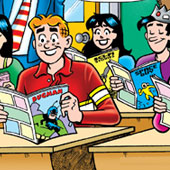• Scope of designers
• Comics and Technology
We have thus seen that comics are now widely accepted in education, both as supplementary materials and as primary, authentic sources that can be studied and critiqued. However, it is obvious that not all comics may be suited to the classroom, and to all kinds of learners; there is no "one-size-fits-all". There is the obvious point of suitability, and it is here that the designer can make a difference. How best can an existing comic be used for classes with specific needs? How best would teachers be able to use comics in the classroom? Can classroom space be modified to accommodate not just comics, but also other newer media like the Internet and the mobile phone?
Comics offer the directness, attractiveness and other advantages of images together with the ease, convenience and portability of print. And should the delivery medium change from print to electronic media, they are equally suited to e-book readers or the computer screen as well. Designers can study ways to further optimize the form of the comic book to make them ever more adaptable. A beginning for this has already been made: Stone (2009) mentions the'vook' (video + book), launched by Bradley Inman, which is an amalgam of multimedia technology (hyperlinks, audio, and video) and printed text. Without doubt, such technology can be added to comics as well, it is up to the designer to see how feasible this is not just for the comic book, but also for the classroom. But one thing is certain: this is a field that is bursting with opportunity, and there is a lot of scope for fresh ideas to make a big difference.

The logo of Vook, a company which makes advanced e-books that include multimedia technology.
Source: http://en.wikipedia.org/wiki/Vook

Bradley Inman, the founder of Vook.
Source: http://en.wikipedia.org/wiki/Bradley_Inman

